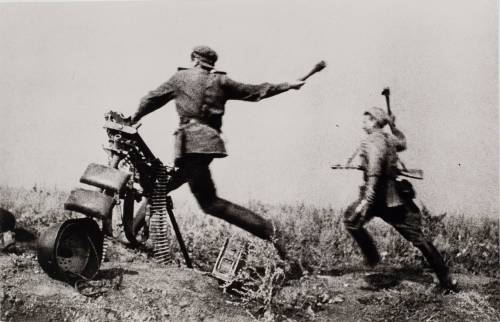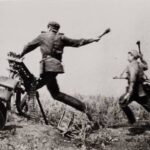“LIFE’S BOURKE-WHITE GOES BOMBING,” reads the headline of an article in Life from March 1, 1943, with pictures of an airborne B-17 and of the eponymous photographer, Margaret Bourke-White, somehow making a padded flight suit look snazzy as she became the first woman to be allowed on an Air Force combat mission. The breakthrough was bound to be hers. She was made a national celebrity by Henry Luce as the premier photographer for Fortune, starting in 1929, and then for the newly founded Life, in 1936. Her skill and charisma are among the things that stand out in “The New Woman Behind the Camera,” a monumental show, at the Metropolitan Museum, of a hundred and eighty-five works by a hundred and twenty female professionals from more than twenty countries which were made between the nineteen-twenties and the fifties. Crowning years of heroic research by the head curator, Andrea Nelson, an associate at the National Gallery of Art, the show builds a case for the historic contributions of women to a field that, until very recently, was monotonously dominated by men. Most of the artists are unknown to me. Nearly all did tip-top work in genres that include reportage, ethnography, fashion, advertising, and determinedly avant-garde experimentation. Widely recognized names—the Americans Berenice Abbott, Dorothea Lange, and Helen Levitt among them—are few. Only Bourke-White really towered in her time.
The irony of Bourke-White’s “Flood Relief, Louisville, Kentucky” (1937), which shows Black victims of a devastating Ohio River flood lined up for aid in front of a huge billboard of a happy (white, of course) family in a car, with the scripted assurance “There’s no way like the American Way,” bites so hard as to scar the soul. (That it’s beautiful amplifies the shock.) Luce let Bourke-White do that. Liberal sentiment was no hindrance to his avidity for sensation. Lange and Levitt did as well or better as social documentarians, with the former’s empathetic coverage of sufferers from the Depression and the latter’s breathtakingly affecting shots of slum children. Levitt’s “New York” (circa 1942) catches three rapscallion boys joyously play-fighting in a rubble-strewn lot. Two of them wield sticks and the other, the smallest, hefts an immense tree branch. The work is a miracle of observation and timing, as one of the smiling stick-holders takes off at a dead run. For me, the over-all image encapsulates a violent happiness, or a happiness in violence, that resonates with millennia of human experience. I can still see it with my eyes closed.
But here I am singling out classics from a show that, nonjudgmental to a willing fault, blurs discriminations of fame and even of originality. The array, installed by the Met’s Mia Fineman, tantalizes to the point of possibly maddening some viewers, with perhaps one or very few prints by photographers who rouse in us a yen to see more of them. In truth, that’s a payoff for Nelson, who imposes no unifying aesthetic beyond a general concordance with modernism. She advances just one, foggy thematic idea: “the New Woman,” a phrase, or slogan, that was coined by two European writers in the late nineteenth century for rebels against Victorian conformity. I think most of us associate it with bobbed-haired partyers in the twenties and the wisecracking heroines of Hollywood comedies in the thirties. Its vagueness serves Nelson’s intent of equalizing all types of photography, without observing a distinction between art and commerce. She and five essayists in the show’s catalogue are at pains to avoid essentializing femininity. There’s reference, but only slight, to our present-day preoccupation with gender identity. The essayists do little opining; one gives a glancing disapprobation of “colonialism” among European and American photographers in Africa, most of whom are from the thirties—easy to judge now but opaque back then. Only a division of bodies of work by category suggests a critical criterion. The show is less a survey than an index. The effect of heterogeneous images in flashing sequence dizzies—physically so, in my case. At certain points, having heedlessly given myself over to too many compelling items, I had to sit down.
Nelson’s catholicity obliges her to include, in a section entitled “Modern Bodies,” a spectacular high-angled view of young Germans doing coördinated pushups, by Leni Riefenstahl, in 1936. Countering that totalitarian mystique are horrific shots of recently liberated concentration camps by Bourke-White and Lee Miller, who, formerly a protégée of Man Ray’s, was, like Bourke-White, embedded with American forces. Exposing the hell of the camps constituted photography’s greatest service to collective memory. Miller’s capture of a leather-coated, handsome S.S. guard, dead and adrift under water, grimly satisfies. (Miller went on to be pictured—not in the show—taking a bath in Hitler’s tub at his apartment in Munich.) A terrific combat photograph by the Russian Galina Sanko, of two running Soviet soldiers in the act of hurling grenades, raises doubts. Was it staged? Who has the sangfroid to perfectly frame an assault on armed enemies who are near enough to throw things at? Sanko, perhaps. Another photograph by her, of German prisoners being hauled across snow on a sled at Stalingrad, affirms her grit. It is reported that she was injured twice during the war.

“During an Attack,” by Galina Sanko, from 1943.Photograph courtesy Robert Koch Gallery
Many of the show’s motifs—of architectural subjects and street scenes, for example—could imaginably have been taken by talented men. This serves the point of establishing an equality, at least, of professional achievement. Femaleness becomes germane intermittently, as in portraiture and self-portraiture of women at work with their cameras and in a few stabs at Surrealism, a movement that was all but defined by poisoned-sugar male treatments of womanhood. A tour de force from 1938, by the German-born Argentine Annemarie Heinrich in league with her sister Ursula, finds the two reflected in a mirrored orb. In the background—from our point of view—Annemarie grins as she snaps the shutter of a standing camera; Ursula looms gigantically and wildly distorted as she leans forward to grasp the sphere. It takes time, enjoyably, to puzzle out the picture’s vertiginous structure. Other works that appeal to me include portraits by Berenice Abbott of her friends Jean Cocteau, aiming a pistol at the viewer, and Janet Flanner, the contributor to this magazine of the Letter from Paris column, who maintains a regal mien despite wearing a funny tall hat with masks attached to it. The show’s chief instance of outright feminist agitation is a shot, by Lola Álvarez Bravo, the great Mexican visual poet of her nation, of a melancholy woman leaning out a window and gridded with shadows: “In Her Own Prison” (circa 1950). An uprising of such inmates was a few short years away.
A mood of buoyancy reigns in a section called “Fashion and Advertising.” Marketing and magazine content targeting female consumers gave women photographers license and authority. The models’ postures took on kinetic vivacity, and jokes became permissible. I only gradually realized that the pert young woman in a 1931 German ad for a hair-styling cream is, in fact, a cunningly made-up mannequin dressed in an old-fashioned blouse. The hand that it appears to extend, presenting the product, is human. Many Weimar fashion photographers were Jewish, finding ways to enter society and to make a living with independent flair. Like every other photographer in the show—however fiercely individualistic—they are implicitly enlisted in a common, retroactive struggle for simple justice.
Now for something that brought tears to my eyes: five shots of an incredible Japanese actress, Yasue Yamamoto, that were taken clandestinely, around 1943 and 1944, after her theatre company was banned by Japan’s wartime government. Wearing a kimono, and either seated or kneeling, Yamamoto enacts moments from a play entitled “Elegy for a Woman,” with tiny shifts of facial expression—mouth closed or slightly open, eyes raised a bit or downcast—that speak or, really, sing of muted emotions that are no less moving for being unidentifiable. The performance was a collaboration with a pioneering Japanese photographer, Eiko Yamazawa. Their complementary artistry, exercised in secret under humble circumstances (a paper screen has holes in it), pierces the heart. The style is flatly vernacular, with nothing fancy or overtly dramatizing about it. The results, feeling timelessly here-and-now across a span of sixty-eight years, didn’t so much blow my mind as take it away and begin to replace it with a better one. ♦
Sourse: newyorker.com


